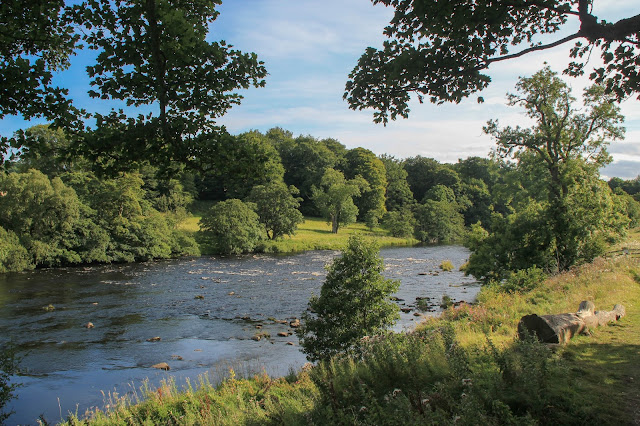If you ever find yourself in Northern England, I strongly suggest a visit to Hadrians Wall. This ancient Roman relic spans the full width of the country here, a whopping 135 km (84 miles). A great friend of mine and I spent two days walking along the wall and enjoying the English countryside. Not really much to say in this post, but it will be picture heavy. Enjoy.
Our journey started in the town of Hexham. We stored our bags at a room there and took off with light packs and some good hiking boots. Taking the public bus out of town, we got off at a stop in what seemed like the middle of nowhere. We had to walk a couple miles North from the road to get to the wall and start our journey East along it. This is the beautiful farmland through which we were walking. We only had one real mishap when my friend ended up thigh deep in some mud along the side of a marsh. That was amusing.
There was plenty of livestock along the way, mostly sheep.
When we got to the wall, we were impressed by the land over which the Romans had built it.
We were also impressed by the quality of their engineering. Almost 2000 years later and it still looks strong and neat.
The wall now is significantly shorter than it was when first built. The original height was ~3 m (10 feet), with some sections as high as 5 to 6 m (up to 20 feet). Now, however, most of it looks like this, about 1.5 m (4.5 feet) or so high.
Remnants of milecastles, outposts at regular intervals along the wall, are still evident. The Roman fortification also boasted a fort every 5 Roman miles along its length. Those Romans really took those Picts seriously and were insistent about keeping them out of their empire.
The surrounding countryside is now a giant patchwork of stone-walled fields, thanks to a couple millennia of shepherding and farming.
The Hadrian's Wall foot path stretches the length of the wall, completely bisecting the country of England (at its thinnest point). Many pilgrims walk the full length of it over a week or so.
The countryside is just stunningly beautiful there in central Northern England. This was in September, and the chill of Autumn was already in the air. It added the faintest hint of how this countryside might prove to be a bit harsher come the Winter months.
The wall stretches and climbs and falls along some impressive hillsides and craggy areas.
Mile by mile, the surrounding landscape changes, but the Wall is ever-present.
The Wall maintains some height along here. The Romans very clearly chose the Wall's path along the crests of high ridges where possible too. Strategic.
As the Sun got lower in the sky, we came closer to our shelter for night one.
After a full day of walking, we stayed the night at this wonderful, perfect little country inn, which lies in farmland within eyesight of the Wall.
The bar there was warm, cozy, and welcoming, with a fire going in the fireplace and phenomenal real ales on tap. A real ale is a traditional English cask ale, stored and served from an oak cask that, due to the cask breathing, limits the carbonation on the ale and ensures the beer is at the same temperature as the cellar it is stored in. Since it isn't pressurized, the tap relies on a hand-pulled pumping system. It isn't for some people who prefer cold, highly-carbonated beers, but I absolutely love cask ales. This inn was like heaven for me.
The food there was amazingly delicious too. Here we have a plate with a fresh baked roll, three chutneys, local hard cheese, and some cured wild boar.
The main course was one of the tastiest things I've ever eaten: wild boar raviolis with a wild mushroom gravy.
We woke up to a beautiful, clear, and crisp morning for day 2 of walking the Wall, though it was sad to leave the warmth, food, and ale of the Twice Brewed Inn.
There are some signs marking the official Wall path, but not too many. For the most part, the path runs right alongside the Wall itself and is difficult to miss.
Another milepost and Crag Lough in the background.
Gates like this were few and far between. It's thought that they served as customs posts for those wanting to do business and trade within the Empire's bounds.
I got very, very excited when we crested this hill and saw the top of that tree below us... I knew we'd come to a place that I remember seeing on TV since I was a child.
Sycamore Gap: a lonely sycamore tree sits at the saddle point alongside the ruins of a well and the Wall itself. This was the setting for a scene from one of my favorite childhood movies, Robin Hood: Prince of Thieves.
The setting itself is really something magical; it transports you to another time and world... some fantasyland full of knights and maidens and dragons and castles from childhood imagination.
Seen from the road, Sycamore Gap is still a special spot.
There is something so very, very charming and quaint about the English countryside.
Another view of Crag Lough
The grass here seems to be trying to bring the Wall back into the ground from which its stones originated.
Another gate, this one with the remnants of the stone arch that stood above it.
After just a couple of hours, we came upon these buildings, which meant that we had made it to Housesteads Fort.
The fort now consists of just the remnants of foundations, but with those alone, an active imagination can fill in the size and order of the ancient military stronghold.
These pillars were a feature representing the brilliance of Roman engineering. In colder climates, Romans employed indoor heating systems that involved fires below stone floors. The floors themselves consisted of huge slabs of flat stone that rested on these raised pillars. The fires would be maintained beneath, heating the stones from below. The Romans also appreciated that fresh, moving air was a good way to prevent mold and mildew, especially in such damp climes as England has on offer. Their structures also incorporated elements to ensure air flow.
Wells like this one were the lifeblood of ancient settlements. Fresh, clean water is not easy to come by in the wilderness.
This reconstruction of the fort demonstrates its scale. It was a big place.
Seen from a distance, the scale of the Fort is also evident.
Nearby to Hexham is another Roman Fort and ruins at Vindabona. Unlike the outpost at Housesteads, Vindabona clearly had a small town that built-up around the fort.
I love the moss on this piece.
Emperor Hadrian? Is that you?
Some of that stone flooring.
This whole floor was elevated. You could walk underneath it, almost standing upright. Amazing.
Check out those water basins.
Latrines. Everybody poops.
This is incredible that this stone vaulted ceiling is still standing after nearly 2000 years.
A beautiful little river runs right alongside the fort-town.



























































































